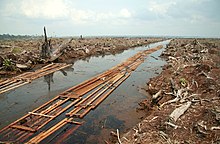Causes

According to the United Nations Framework Convention on Climate Change (UNFCCC) secretariat, the overwhelming direct cause of deforestation is agriculture. Subsistence farming is responsible for 48% of deforestation; commercial agriculture is responsible for 32%; logging is responsible for 14%, and fuel wood removals make up 5%.
Experts do not agree on whether industrial logging is an important contributor to global deforestation. Some argue that poor people are more likely to clear forest because they have no alternatives, others that the poor lack the ability to pay for the materials and labour needed to clear forest. One study found that population increases due to high fertility rates were a primary driver of tropical deforestation in only 8% of cases.
Other causes of contemporary deforestation may include corruption of government institutions, the inequitable distribution of wealth and power, population growth and overpopulation, and urbanization. Globalization is often viewed as another root cause of deforestation, though there are cases in which the impacts of globalization (new flows of labor, capital, commodities, and ideas) have promoted localized forest recovery.
Another cause of deforestation is climate change. 23% of tree cover losses result from wildfires and climate change increase their frequency and power. The rising temperatures cause massive wildfires especially in the Boreal forests. One possible effect is the change of the forest composition.
In 2000 the United Nations Food and Agriculture Organization (FAO) found that "the role of population dynamics in a local setting may vary from decisive to negligible", and that deforestation can result from "a combination of population pressure and stagnating economic, social and technological conditions".
The degradation of forest ecosystems has also been traced to economic incentives that make forest conversion appear more profitable than forest conservation. Many important forest functions have no markets, and hence, no economic value that is readily apparent to the forests' owners or the communities that rely on forests for their well-being. From the perspective of the developing world, the benefits of forest as carbon sinks or biodiversity reserves go primarily to richer developed nations and there is insufficient compensation for these services. Developing countries feel that some countries in the developed world, such as the United States of America, cut down their forests centuries ago and benefited economically from this deforestation, and that it is hypocritical to deny developing countries the same opportunities, i.e. that the poor should not have to bear the cost of preservation when the rich created the problem.
Some commentators have noted a shift in the drivers of deforestation over the past 30 years. Whereas deforestation was primarily driven by subsistence activities and government-sponsored development projects like transmigration in countries like Indonesia and colonization in Latin America, India, Java, and so on, during the late 19th century and the earlier half of the 20th century, by the 1990s the majority of deforestation was caused by industrial factors, including extractive industries, large-scale cattle ranching, and extensive agriculture. Since 2001, commodity-driven deforestation, which is more likely to be permanent, has accounted for about a quarter of all forest disturbance, and this loss has been concentrated in South America and Southeast Asia.
Comments
Post a Comment